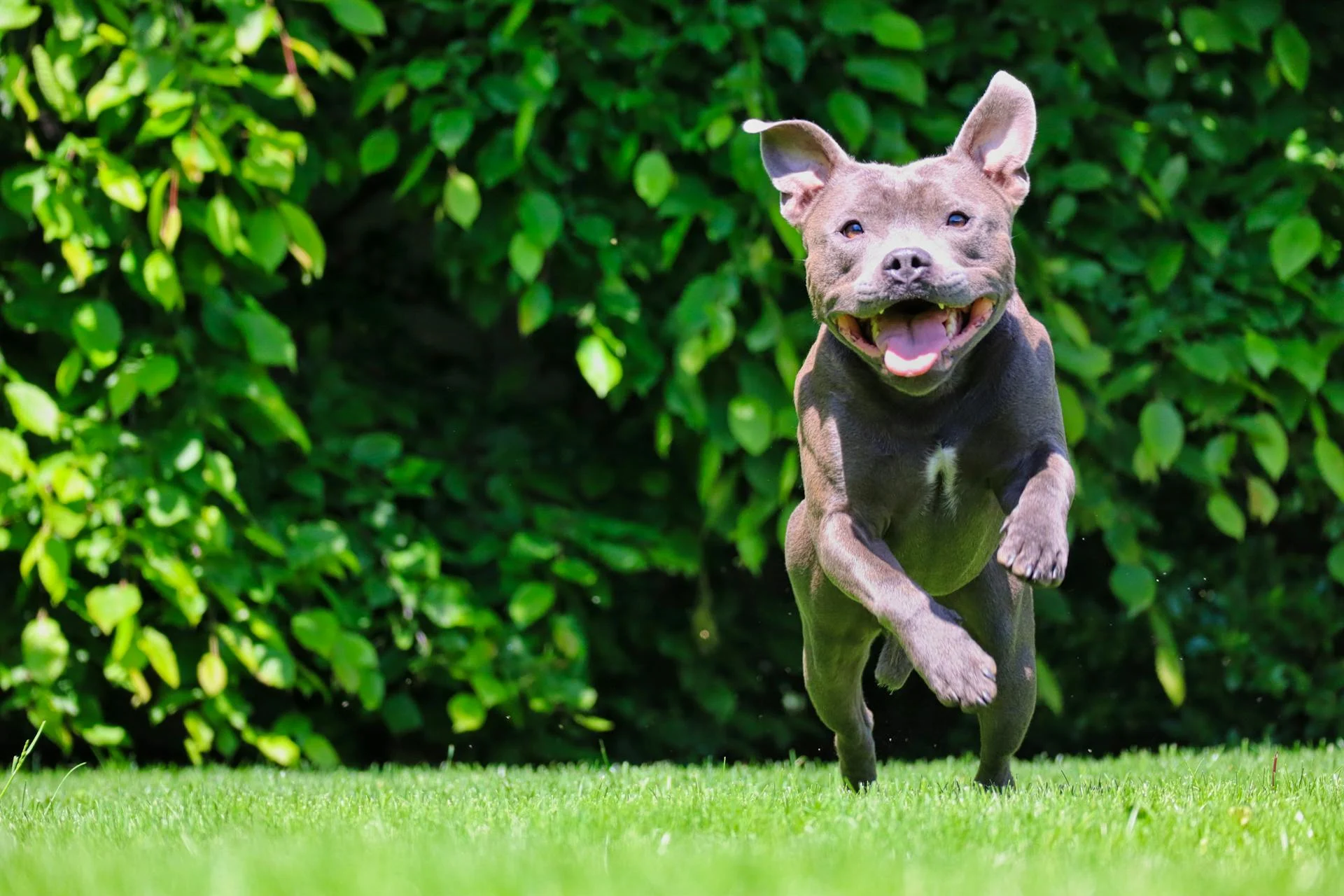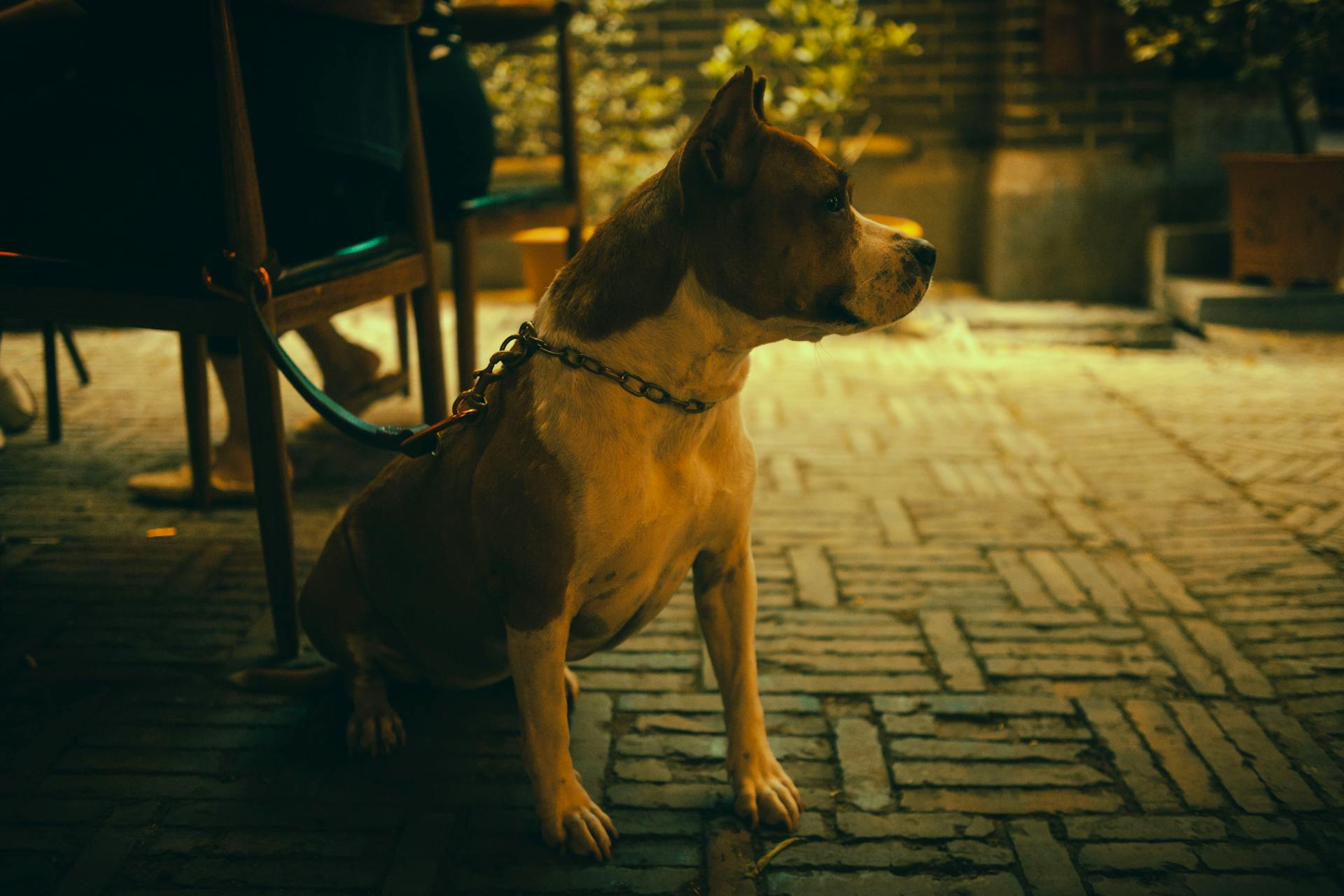
Pit bulls have a bad reputation, but is it deserved? According to the American Temperament Test Society, pit bulls have a passing rate of 86.8%, which is higher than many popular breeds like Chihuahuas and Beagles.
However, some people may still be concerned about pit bulls due to their strength and athletic ability. Pit bulls were originally bred for bloodsports like bull-baiting and dog-fighting, which required them to be powerful and agile.
But being strong and athletic doesn't necessarily mean a pit bull is aggressive. In fact, many pit bulls are friendly and loving companions, as seen in the many stories of pit bulls being used as therapy dogs and service animals.
The key to a pit bull's behavior lies in its upbringing and training, not its breed. With proper socialization and training, a pit bull can be a wonderful addition to any family.
Are Pit Bulls Dangerous?
Pit Bulls are often misunderstood, but the data shows that they're not inherently aggressive. In fact, a study of 2,000 dog bites in the US found that Pit Bulls were responsible for only 6.4% of the bites.
Breed-specific legislation has been implemented in many cities to restrict ownership of Pit Bulls, but this approach has been largely ineffective in reducing dog bites. According to the American Temperament Test Society, Pit Bulls have a passing rate of 86.8%, which is higher than many other breeds.
Pit Bulls are also highly trainable and are often used as therapy dogs, search and rescue dogs, and service dogs. With proper training and socialization, Pit Bulls can make wonderful family pets.
Breeders and owners have been working to improve the reputation of Pit Bulls by promoting responsible breeding and ownership practices. Many Pit Bull owners report that their dogs are gentle and loving companions.
Pit Bulls are also prone to certain health issues, such as hip dysplasia and allergies, which can affect their behavior and overall well-being. Regular veterinary care and a balanced diet can help mitigate these issues.
Pit Bull Facts
Pitbulls are more likely to cause significant injuries than many other dog breeds.
Proper socialization and training of Pitbulls can result in a welcome companion and family dog, but it requires consistency from owners. In fact, Pitbulls were even called "nanny dogs" in the early 1900s because of their loyal and gentle nature toward humans, and especially children.
About 20% of the dogs in the United States are classified as Pitbulls, despite their reputation.
Key Points
Pitbulls are more likely to cause significant injuries than many other dog breeds, which is why it's essential to take precautions when interacting with them.
Pitbulls are statistically more likely to bite than other breeds, even outperforming Rottweilers in reported dog bites.
Appropriate and immediate medical care for any dog bite can help the victim avoid infection and other complications. This is crucial in preventing long-term damage.
Proper socialization and training of Pitbulls can result in a welcome companion and family dog, but it requires consistency from owners. This includes regular exercise, training sessions, and positive reinforcement.
If your Pitbull bites someone, it may result in a legal claim or lawsuit against you, the dog owner. Fortunately, a dog owner's home or renter's insurance policy may cover the attack.
Here are some key statistics to keep in mind:
- Pitbulls are about 20% of all dogs in the United States.
- Pitbulls were once called "nanny dogs" due to their loyal and gentle nature toward humans, especially children.
Different Types of
There isn't an official "Pitbull" breed, but rather four breeds that are commonly classified as "Pitbull-type" breeds.
The American Pitbull Terrier is the tallest of the four breeds, known for its athletic build.
The American Staffordshire Terrier is slightly shorter and stockier than the APBT.
The Staffordshire Bull Terrier is the smallest of the four breeds.
The American Bully is the stoutest of the four breeds, with an appearance similar to the classic American Bulldog breed.
Here's a quick rundown of the four breeds:
- American Pitbull Terrier: Tallest and most athletic
- American Staffordshire Terrier: Slightly shorter and stockier
- Staffordshire Bull Terrier: Smallest of the four
- American Bully: Stoutest, with an American Bulldog-like appearance
Origins and Nature
The American Pit Bull Terrier is technically the only true pit bull, although the American Staffordshire Terrier and Staffordshire Bull Terrier are often referred to as pit bulls. So are a handful of other breeds and mixed breeds.
Pit bulls were originally used for bull- and bear-baiting. They had a fabulous reputation early on and were considered the ideal family pet because they were so good with people.
Petey from The Little Rascals was a pit bull. Helen Keller, President Theodore Roosevelt, and Fred Astaire all had the breed as family pets.
The tide turned in the late 1990s, when pit bulls became popular among people who weren't focused on the positive attributes of the breed. They were looking for a strong, scary-looking dog.
Recommended read: What Breed of Pit Bulls Is the Biggest
Prevention and Safety
Pitbull owners can take several steps to prevent their dogs from biting. The key is to start training early and teach them that biting has consequences.
Dogs are animals and may bite out of excitement or in play, but this behavior can be curbed with proper training. Making a big fuss over biting, saying "OUCH" loudly, and acting as if you're hurt can help teach them to respond properly.
A stern "NO" command and giving the dog a time-out for a few minutes can also help discourage biting behavior. Adequate exercise is also crucial, as a lack of physical activity can lead to agitation and aggression.
To channel their energy into something safe and productive, consider enrolling your dog in obedience class and rewarding good behavior with plenty of affection and treats. This will help teach them that not biting results in a reward.
Here are some additional tips to consider:
- Understand that a dog's "fear" is often the trigger for aggressive behavior, so socialize your dog properly.
- Curb food aggression early by taking the food away from your puppy for a few minutes.
- Teach your dog a "drop it" command to stop biting.
- Walk away and ignore your dog if they bite for attention.
- Make sure your dog is spayed or neutered.
Treating Dog Bites
If you're bitten by a dog, it's essential to act quickly and follow the right steps to prevent infection and other complications. According to The Cleveland Clinic, you should immediately wash the wound using mild soap and warm tap water for 5-10 minutes.
Apply pressure to the wound with a clean cloth to slow the bleeding. You can also apply over-the-counter antibiotic cream if it's available. It's crucial to wrap the wound in a sterile bandage to keep it covered and prevent infection.
You should see your doctor as soon as possible, even if the wound doesn't seem serious. In fact, The Cleveland Clinic recommends seeking professional medical care within eight hours of a bite. Change the bandage several times a day, or according to your doctor's recommendations, to keep the wound clean and promote healing.
Watch for signs of infection, such as redness, swelling, increased pain, or fever. If you notice any of these symptoms, call your doctor right away. Tetanus or lockjaw can be a possible complication of dog bites, especially if the wound is not properly cared for.
Rabies is another significant concern, especially if the attack was from a stray dog or one who is not cared for properly. A course of immunizations may be necessary, as the disease can be fatal if not treated early enough.
Here are the 7 steps to treat a dog bite wound:
- Wash the wound using mild soap and warm tap water for 5-10 minutes.
- Slow the bleeding with a clean cloth by applying pressure.
- Apply over-the-counter antibiotic cream if it's available.
- Wrap the wound in a sterile bandage.
- Keep the wound covered and see your doctor as soon as possible.
- Change the bandage several times a day, or according to your doctor's recommendations.
- Watch for signs of infection, such as redness, swelling, increased pain, or fever.
Preventing Dog Bites
Preventing dog bites is crucial for the safety and well-being of both humans and animals. According to experts, aggressive behavior in dogs is often learned through abusive treatment or training, not due to a specific breed.
To curb aggression in Pitbulls, start training early. Like any other puppies, pit puppies might bite out of excitement or in play. It's crucial to take immediate steps to teach them there are consequences for this action.
Making a big fuss over biting is an effective way to discourage it. Say "OUCH" loudly and act as if you're hurt, and the dog will respond properly as he wants your attention and love.
Using the command "NO" in a stern voice is also a good technique. Immediately stop paying attention or playing with the dog for a few minutes (give him a time-out) to reinforce the behavior.
Adequate exercise for these athletic dogs is pivotal; without it, they may grow agitated, which can lead to aggression. Food aggression must also be curbed early, or it could become a life-long habit.
Here are some key tips to prevent dog bites:
- Make a big fuss over biting.
- Use the command "NO" in a stern voice.
- Immediately stop paying attention or playing with the dog for a few minutes.
- Understand that a dog's "fear" is most often the trigger for aggressive behavior.
- Provide adequate exercise for your dog.
- Curbs food aggression early.
- Teach your dog a "drop it" command.
- Walk away and ignore the dog if it bites for attention.
- Enroll your dog in obedience class.
- Spay or neuter your dog.
- Reward good behavior with plenty of affection and treats.
Striking a dog will never work well – it may trigger fear that compounds the problem. Instead, introduce positive reinforcements to teach them that not biting results in a reward. This will ultimately bring their biting under control and keep you from legal action later.
Frequently Asked Questions
Is it true that pit bulls turn on their owners?
Pit bulls are no more likely to suddenly turn on their owners than any other breed. Their behavior is often unpredictable, but not inherently aggressive towards their owners.
Are pit bulls good family dogs?
Yes, well-managed Pit Bulls can make excellent family dogs, known for their stable temperament and affectionate nature. They're often considered one of the best breeds for families with children.
Are pitbulls OK with other dogs?
Pitbulls can vary in their tolerance for other dogs, ranging from poor greeting behavior to being very dog-friendly. Proper introduction and understanding of your Pitbull's personality is key to determining their compatibility with other dogs
Why is my pit bull attacking my other dog?
Dogs may attack each other due to dominance, territorial, possessive, or fear/anxiety issues. If you suspect your pit bull is attacking your other dog, understanding the underlying cause is crucial to resolving the behavior
Why do pitbulls have the highest attack rate?
Pit bulls are more likely to be involved in fatal attacks due to their aggressive breeding and tendency to fight without warning. Their history of selective breeding for aggression makes them a higher risk for serious attacks.
Sources
- https://atlantaadvocate.com/legal-guides/dog-bites/pitbull-dog-attacks/
- https://time.com/2891180/kfc-and-the-pit-bull-attack-of-a-little-girl/
- https://www.thehumanesociety.org/debunking-pit-bull-myths/
- https://www.aspca.org/about-us/aspca-policy-and-position-statements/position-statement-pit-bulls
- https://www.webmd.com/pets/dogs/features/pit-bulls-safety
Featured Images: pexels.com


